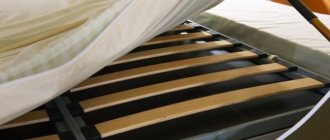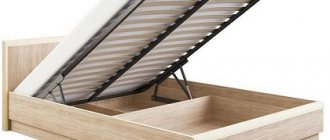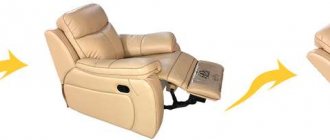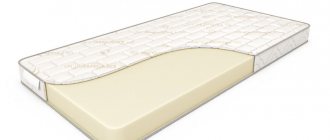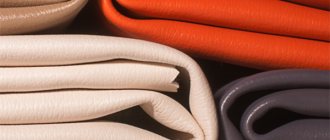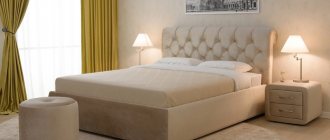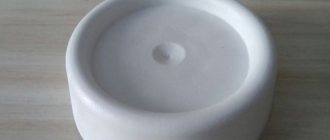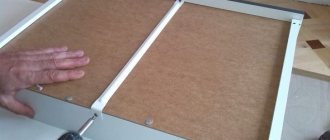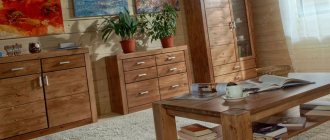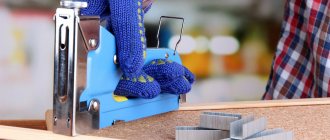What are bed slats
The slats in the bed are structural elements of the slatted base on which the mattress is placed. They are wooden slats (see photo below) installed across the base at a certain distance from each other. In order to create an elastic base during installation, they must have a C-shape, slightly curved upward.
Photo: Bed with slats (slat base)
What are they needed for
In the overall design, the slats have many useful functions:
- create natural ventilation for the mattress due to the presence of gaps between them;
- needed to reduce the load on the bed frame. Evenly distribute the weight of the mattress under itself, thereby extending the life of the bed;
- thanks to the curved shape, they create a light springing effect and increase the anatomical effect of the mattress, complementing its orthopedic properties;
There are also special orthopedic lamellas that allow you to adjust the rigidity of the base at its various points, selecting the optimal rigidity characteristics for the physiological characteristics of the sleeper. However, their high price does not yet allow this invention to become a mass product.
Photo: Orthopedic base for a slatted bed
Main features of bed slats
They are a plate or panel made of wood. They are included in the main part of each bed, assembled using modern technologies.
The main feature is the “C” shape
They can also support quite a large mass (the weight of a person and a mattress).
The slats are made from:
- The most affordable and very plastic material is birch.
- An analogue of birch in terms of characteristics is linden.
- Beech.
- Ash.
- Maple.
Lamels made from birch are otherwise called armor. They are very popular and affordable.
Beech and ash slats are expensive and are included in the design of beds that are made only from wood, or rather solid wood.
The cheapest option is birch slats, the most expensive is beech
Lamels have the following positive qualities:
- Increased elasticity.
- Lightness of the plates.
- Extend the life of the bed as a whole.
- They have a springing effect.
- Thanks to them, air circulates more actively.
- Correctly support the spine during sleep.
- Not difficult to repair and maintain.
There is always a conflict between the slats and the springy base of the mattress. Such a bed base is quite expensive, and there are also certain sizes. This is the main disadvantage of lamellas.
What are lamellas made of?
These structural elements can be made of wood as well as metal.
Wooden
Wooden bed slats are made from birch, linden, ash, maple, and beech. The most common and inexpensive are birch. They are light in weight and handle loads well. The most durable are beech.
Metal
They are much less common than the previous version. They differ in that they do not change their hardness throughout the entire service life. They do not bend under the mattress, but they have significant weight and can also make squeaks.
If the metal slats have an anti-corrosion coating, then the bed can be used in any humidity and temperature conditions.
It is also important that fewer crossbars made of metal are required than wooden ones. Cast welded bases do not require a special central guide. Metal slats are often used in beds with a lifting mechanism due to their significant weight.
Sizes of bed slats
There are two types of lamellas in width: narrow and wide.
- Narrow ones (30-40 mm) must be placed in two rows, with each sleeping place having a separate base. This type of lamella arrangement is suitable for mattresses with independent springs.
- Wide slats (50-70 mm) are arranged in one row, unlike narrow ones, and are most often used in single or single beds. Wide slats are suitable for use with springless mattresses, as well as with Bonnell spring models.
The most acceptable thickness of the slats is 8-10 mm. The length of the slats may vary depending on the width of the bed.
Number of slats per bed
The number of slats depends on the material from which they are made. You will need less metal ones than wooden ones.
If we talk about wooden ones, then usually 25-30 pieces of bent-glued plates are used for a double bed. There are at least 15 slats per single bed. For comparison: you will need only 8-10 metal slats for a single bed.
The more slats are used, the better they will be able to withstand the load and provide flexibility to the base and cushioning of the mattress. But the fewer there are, the more it is ventilated.
Quantity
When making slats for a bed with your own hands, it is important to know how many elements should be in the design. You also need to pay attention to this indicator when choosing furniture. The total number of armor depends on the material of manufacture. Durable, mechanically resistant slats can withstand significant weight even in small quantities. This explains why a metal bed has fewer plates compared to its wooden counterpart.
The second indicator that determines the number of slats is the number of beds. For a wooden double bed you need 25 to 30 slats. The minimum for a single-seat model is 15 pieces. The number of metal plates in a bed per person can be reduced to 10 or even 8 pieces.
The more latoflexes in the base, the more reliable the structure, but the worse the mattress is ventilated.
The position of the bed slats is determined not only by their number, but also by their distance. The pitch between the battens is also affected by the length of the berth. A bed with a wide sleeping area requires more closely spaced slats. The relationship between their number, the distance between them and the length of the bed is presented in the table.
Types and characteristics of lifting mechanisms for beds, selection rules
| Bed length, cm/Pitch between battens, cm | 7 | 4 | 2,5 |
| 190 | 14 pieces | 18 pieces | 22 pieces |
| 200 | 16 pieces | 20 pieces | 24 pieces |
In any case, the distance between latoflexes should not exceed their width.
The number of slats in the base is affected by the material of manufacture and the number of beds
The more often the latoflexes are located, the more reliable the design, but the worse the mattress is ventilated
The pitch between the battens also depends on the length of the berth
A bed with or without slats: which is better?
The choice of slats material depends on the preferences, as well as the financial situation of the buyer.
It will be more difficult and expensive to manufacture a slatted bottom; a solid bottom is cheaper, but it provides worse orthopedic properties of mattresses. Most mattresses reveal their properties precisely in tandem with slats.
For comparison, let's look at the advantages and disadvantages of each of the bases.
Solid bed bottom
Pros:
- Ease of manufacture and versatility.
- Suitable for people with spinal problems who need a flat and hard surface.
Minuses:
- poor ventilation;
- does not have springing properties;
- provides worse orthopedic properties of the mattress.
Lamellar base
Advantages of lamellas:
- Excellent ventilation.
- The orthopedic properties of the mattress increase.
- The slatted bottom type is more suitable for those who do not have too much weight.
- If the slats break, they can always be replaced, but if the bottom of the bed breaks, it can only be taken to a landfill.
- One lamella can withstand a load of 12 kg and in case of breakdown you will not have to change all the lamella fastenings.
- The bed is easier to move and transport.
- Plastic lat holders do not creak.
- Flexibility and resilience.
- Affordable price.
- Quick replacement.
- Easy to disassemble and assemble.
- Suitable for beds with a lifting mechanism.
- Has springy properties.
Minuses:
- may break;
- the cheapest models may squeak;
- Sometimes the slats pop out of the plastic tips.
To summarize, we can conclude that the base with slats wins on many counts. In the vast majority of cases, this is what is best for the bed.
How to choose a bed base?
The base is one of the main parts of the sleeping place, what the mattress rests on.
It is attached to the bed frame or used as an independent sleeping place if it has legs. A high-quality base enhances the orthopedic properties of the mattress and provides a person with a healthy and comfortable sleep. Bases vary in type, design, and material. To make the right choice, “O, mattresses!” invites you to familiarize yourself with the features of modern foundation models.
Size
The dimensions of the bases correspond to the standard sizes of single, single and double beds (from 60x120 to 200x220 cm). On our website you can purchase bases for non-standard beds, made to order.
Solid. This type of base is gradually losing its popularity, but is sometimes acquired by people with spinal problems, who are recommended to sleep on flat and hard surfaces. The solid base consists of boards, plywood or chipboard sheets. Orthopedic mattresses on a solid base lose their useful properties and are poorly ventilated, due to which they wear out faster. The main advantage of these models is their low cost.
Orthopedic. Due to flexibility and elasticity, they allow mattresses to fully demonstrate their orthopedic properties. They consist of lamellas (slats) attached to the frame using special fasteners - lath holders. Lat holders are mortise and overhead, made of rubber and plastic. The slats provide air and heat exchange in the mattress, which guarantees a healthy microclimate of the product and extends its service life. The recommended minimum number of slats per bed is 15 pieces.
Slat width
Different models of orthopedic bases have different numbers of lamellas, and their width also varies. The closer the slats are to each other, the stronger the base and the more weight a person can withstand. The distance between the lamellas should not be greater than the width of the lamella in this base.
Narrow (3-4 cm). They are considered the most orthopedic option. Bases with narrow slats are suitable for springless mattress models and especially mattresses with an independent spring block with a large number of springs per bed. For heavier people, bases with small-width slats made of durable beech or oak are recommended.
Wide (5-9 cm). Mattresses with an independent spring block with a large number of springs per bed are not suitable, since the springs can fall between the base slats. In other cases, suitable for any mattress model. Bases with wide slats made of birch or pine are designed for lighter loads.
Design
1. Collapsible bases.
A convenient option for transportation to the country, when disassembled it easily fits into a car. It consists of lamellas (slats), a frame, lath holders and legs (if any), which are assembled in accordance with the instructions. The orthopedic properties of such bases are not lost.
2. One-piece design.
The one-piece bases require no assembly and are ready to use. Suitable for home. They can be either solid or orthopedic type, made of metal or wood.
3. Lifting.
Such models are equipped with a lifting mechanism that allows you to raise the base and provide access to the drawers under the mattress, where bedding, toys and other things are stored. This is convenient in small bedrooms as it saves space. Lifting mechanisms can be manual, gas, or spring.
4. Frameless (liners).
Orthopedic bases made of lamellas without supports (legs) and without lath holders, are not attached to the frame. The slats are fastened together with tape and are inserted into the bed frames. Mobile and do not require assembly.
5. Transformable.
Premium orthopedic bases. Due to a special mechanism, the base - transformers can be adjusted to the position of the body.
For example, you can raise the head of the bed to watch TV or read a book, and raise the bottom of the base to ensure a comfortable position for your feet. Raised using manual adjustment or remote control.
6. With adjustable hardness.
Thanks to special adjustable attachments on the lamellas, you can adjust the rigidity of the base to specific requirements and health conditions. The rigidity is adjusted by moving the nozzle along the rail. Some models of bases have a block of adjustable lamellas only in the lumbar region, while in other models each lamella has the ability to adjust the rigidity.
The slats on the bed are creaking: what to do?
To assess the scale of the problem, you need to take a closer look not only at the slatted base, but also at the mattress, support slats, and also at the lifting mechanism, if any.
Why do the slats creak?
The base of a bed with slats creaks most often for two reasons:
- The fasteners were not tightened properly.
- Wooden elements rub against each other.
If the creaking of the lamellas began a year or two after purchase, then the wood may also be drying out. This process is completely natural and is influenced by the material of the boards from which the slats are made, as well as the microclimate of the room.
Material with low hygroscopicity practically does not creak. Indoor humidity of less than 50% slows down the drying process of the boards and, thereby, extends their service life.
What to do if the slats on the bed squeak
If you determine that it is the slats that are creaking, then you need to click on each one and determine which of the slats the sound comes from. They should also be checked for chips, cracks and other integrity problems. If damage is detected, the lamellas must be replaced. This will help remove the squeak and correct the situation.
Important! The slats should not wobble or dangle, all screws and screws should be in their places.
Features and purpose
Modern mattresses require the most even base possible, making the sleeping person feel comfortable. An orthopedic bed frame with a rigid structure significantly extends the life of the mattress. On the sides, the structure has small sides that fix the position of the mattress. The central part of the metal frame is filled with special curved planks, which are called lamellas or armor.
Only high-quality, well-dried wood is used in the manufacture of bed slats. In production, the array is sawn into layers, which at a certain temperature are impregnated with an adhesive composition and become slightly curved. An important characteristic of finished products is their elasticity, which is possible due to the uniform arrangement of wood fibers. Therefore, not any wood is used in production, but only beech, birch, ash, maple, poplar. For additional protection against changes in humidity, the products are varnished.
The thickness of the plates ranges from 1-10 mm, width - 25-120 mm. When laying them in the base, the distance between the products from each other can be 2-6 cm. In the designs for double beds, two rows of slats are provided, separately for each sleeper.
More frequent installation ensures maximum reliability, which allows the bed to be used even by a person with significant weight. The maximum distance between the slats is chosen for light loads on the mattress. The standard for the base of a double bed 160x200 cm is considered to be a design with 30 crossbars. A smaller number may not provide the required strength. The minimum value is 22 slats for a double base.
The main functions of the rack base include:
- Ensuring good ventilation of the mattress. A lot of air enters the spaces between the slats, which maintains the optimal temperature at the point of contact between the body and the mattress;
- To fix the plates, special holders are used, which ensure a silent design;
- The flexibility and elasticity of the slats allows the mattress to take the most physiological position, which ensures good sleep and complete restoration of strength;
- Reducing and evenly distributing the load on the mattress, which significantly extends its service life. The likelihood of pathogenic microflora multiplying inside the mattress is reduced;
- The products are low cost, they do not greatly affect the final cost of the bed;
- The high base makes cleaning easy. The trash under the bed can be quickly swept away.
When choosing a bed or a base for it, it is important to explore the possibility of purchasing accessories in case of breakage or damage to any parts. Accessories for beds include not only slats, but also transformation mechanisms, lath holders, gas lifts for lifting mechanisms. If the orthopedic base has been damaged due to improper use, then it is possible to replace the damaged slats for the bed with your own hands. Breakage of lamellas often occurs when the air inside the room is too dry, when the wood dries out. In this case, it is recommended to regularly clean the surface of the planks with a damp cloth.
The slats fall out of the bed: what to do
This can happen either when the frame is assembled incorrectly, or the cause may be a technological defect. Perhaps the slats and lath holders are not designed for this bed. It is important to check and tighten the bolts of the sidewalls and corners.
Today, more and more often, solid bottoms are being replaced by beds that have slats in their design. After all, the slats themselves serve as an orthopedic bed, due to the fact that they enhance the effect of the mattress. Only with the correct position of the sleeper can sleep be full and healthy, so you need to choose slats in accordance with your state of health, weight, financial situation, and you should also consult with a good specialist.
